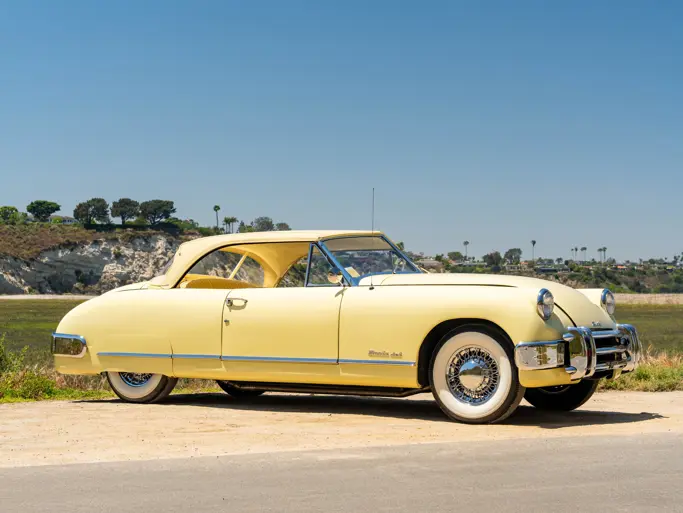
1929 Packard 640 Custom Eight Runabout
{{lr.item.text}}
$189,750 USD | Sold
{{bidding.lot.reserveStatusFormatted}}
- 384.8-cid, 106-hp inline eight-cylinder engine
- Three-speed manual transmission
- Beautiful professional restoration
- CCCA Premier Classic National Sr.1st Prize winner
- Many desirable features exemplified by Classic Era
- Fantastic period-correct colors
- Wonderful detailing throughout
On January 23, 1929, The Scranton (PA) Republican newspaper proclaimed on page 17 that “Packards Shown at Special Salon.” The story continues with the following: “Because of the comprehensive line of Packard motor cars and the necessarily limited space at the Armory, Packard cars will be displayed only at a special Packard salon in the Scranton Packard headquarters in Lackawanna Automobile company Wyoming avenue at Vine street all this week. The Lackawanna Automobile company is distributor for all northeastern Pennsylvania, and has the largest display rooms in the entire Eastern United States, even exceeding in size most of the metropolitan branch salesrooms. Special decorations and flood lighting are being employed to make this the finest showing of Packards held anywhere in the east.”
Packard, like many other American luxury car manufacturers, was not immediately affected by the stock market crash of 1929. In fact, the company continued to employ over 7,000 workers and its commanding buildings loomed over both sides of Detroit’s East Grand Boulevard. What’s more, Packard introduced the 640 Custom Eight that year. Clients had a choice of five basic models improved with such advancements as a shock absorbing “loose trunion” suspension with new Houdaille shocks, an in-dash gauge that replaced the Moto-Meter, and an automatic cylinder oiler. Cosmetically, these Sixth Series Packards received parabolic headlamps and chromed brightwork. The Sixth Series 140.5-inch wheelbase 640 Custom Eight would be available in nine different body styles and, in total, 4,853 of this model would be produced for the 1929 model year.
As detailed in the January/February 2007 issue of Torque, a publication of the CCCA’s Michigan chapter, this 640 Custom Eight was acquired by its current owner in March 2002 after having received restoration work in 1999 from renowned expert Jack Dietz, curator of the William Lassiter, Jr. Collection. Shortly before its acquisition, the car was expertly detailed and freshened before receiving a complete body-off restoration by R&A Engineering of Michigan two years later. A CCCA Premier Classic, the car has since been awarded numerous honors at several prestigious concours events that includes Amelia Island Concours, Ault Park Concours and Lake Mirror Classic.
During its restoration, the car was finished in black with orange artillery wood spoke wheels and a beige folding top piped in saddle leather to match the richly appointed interior leather on the doors and seats – a color combination believed to be more typical of the era and very authentic for a Sixth Series Packard. In fact, the June 1929 American Motorist magazine featured a black and orange roadster in an ad titled “Packard men are carefully chosen.” The car remains in show-quality condition throughout, from the beautifully upholstered rumbleseat to the restored and detailed engine bay. The power comes from Packards 384.8-cid, 106-hp inline eight-cylinder engine which is mated to a three-speed manual transmission.
The radiator features an optional basket-weave stoneguard and is accented by the distinctive Adonis radiator mascot. The windshield is hinged to be able to access fresh air. Other notable extra features include dual spotlights, a wood rail rear-mounted trunk rack, and dual side-mounted spares with tire-mounted rearview mirrors. A note of distinction and detail must go to the golf club access door housing a set of period clubs. Subtle gold pinstriping is found on the orange wheels and belt moldings.
The Runabout was Packard’s least expensive Custom Eight, although it must be considered that with prices exceeding $3,000, it was by no means affordable to the average American. The Scranton Republican article concluded that “The color combinations are masterpieces of the designer’s art from the finest craftsmen. Packard specialists will be on hand to explain the numerous Packard exclusive features and to point out the many reasons why Packard automotive engineers are regarded as leaders in the industry.”
After nearly 90 years, these roadster bodies have become particularly sought after by collectors as they epitomize truly open motoring and embody the classic Packard grandeur of a bygone era. One thing is certain, the beauty and quality presented by Packard in 1929 has been forwarded with this car, and it is undeniable.


 | Fort Lauderdale, Florida
| Fort Lauderdale, Florida


